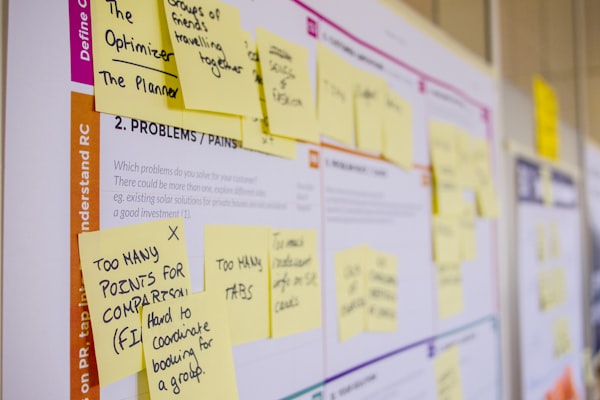What does "best practices" mean when designing and building online portals, websites or apps? How can you ensure that your next digital project provides a good service to your customers?
Since 2011 in the UK, the government has heavily invested to implement a "digital by default" vision for all government agencies. The Government Digital Service team developed the Service Standard to help teams create and run great public services. This standard defines a set of 14 rules and principles to follow best practices when building a digital service for users. Each item on the standard is like a building block for creating a user-focused website or app that is secure and flexible enough to evolve over time.
Having gone through it successfully for a handful of projects with the Cabinet Office and the College of Policing, I believe most private enterprises should follow the same Service Standard for their corporate digital transformation projects. Too often, I see briefs and RFP that are missing important elements or activities that ultimately have a detrimental effect on the end delivery.
At a high-level, the Service Standards can be grouped into 3 main objectives that every product needs to follow:
• Meet User Needs (GDS Service Standards 1 - 5)
• Provide A Good Service (GDS Service Standards 6 - 10)
• Use The Right Technology (GDS Service Standards 11 - 14).
Let's explore each element of this Gov.uk Service Standard and why you should follow it on every digital project, even outside of the public sector.
1. Understand users and their needs
This first point closely ties with the roots of User Experience and the need to learn. When building a digital product, the target audience is usually quite varied with Every user or "persona" having different expectations about what they are looking for and how they might use your digital platform:
- A simple website might attract customers from different experiences or geographical locations, investors and the media for example;
- An eCommerce site might have a range of products for different budgets, gender or taste;
- A Software-as-a-Service platform might target single users, teams and enterprise packages.
The best way to learn about those needs is to perform user research. By speaking to real users (existing users or potential customers) from the various groups, a user experience designer will be able to extract information about the user expectations, pain-points and start to make decisions on how to solve them.
You’ve got to start with the customer experience and work backward to the technology. You can’t start with the technology and try to figure out what problem you’re going to solve.
Steve Jobs
Combining this with a content audit and analytics review, the UX researcher will gather a lot of information to start building shared persona needs and document them to support all future design decisions.
2. Solve a whole problem for users
We discussed the challenges of having a wide range of target users needs that could be challenging to accommodate all in one platform. Once you expand your horizon to learn from your vast set of users' needs, you need to flip this around and bring back focus. It's important to clearly define what your mission is and not try to do too much. You do not need to be everything to everyone.
In the corporate world, departments can work in isolation and there is a risk of wasting efforts. Our most successful clients are running "Project Board / Steering Committee" where the senior leadership team can share knowledge across the group. It will also raise items you may not have considered such as legal or compliance requirements. By opening up your brief and roadmap to a larger group, you will benefit from external knowledge and insights to better interconnect your website or app with other organisation workstreams (such as a centralised CRM or better connect sales and support experiences).
Sometimes, the best idea can even be to NOT create a new website! What about adding landing pages to an existing site you own? Or partnering with a supplier or 3rd party to use their API or dataset to present on your portal? I’ve seen many companies coming to us with the challenge of having “too many websites” and a new project to merge them back together when creating new sites for every campaign got out of control!
You need to do the hard work and don't make the end-users think too hard! Solve a specific problem for them and do it extremely well. You can then iterate over time and slowly widen the range of your service to bring additional values to your customers.
3. Provide a joined-up experience across all channels
This is another no-brainer for digital projects in the corporate world: use the existing knowledge across your teams to build a better product! We do this by starting the immersion / discovery phase with stakeholders’ workshops including representatives from multiple departments and making sure designers and user researchers are working with front line operations staff.
Your new corporate website revamp project might be driven by the Marketing team but need to involve:
• The sales team to understand how customers feedback during real-life pitches or contract negotiation;
• The customer service team bringing knowledge about customer queries from the ticketing system or call centers;
• The finance team to understand how to reconcile transactional data;
• The compliance team around all legal points on GDPR data capture or procurement due diligence;
• The IT / InfoSec team to get the right tools deployed and secured.
The purpose of those collaborative workshops is to build a User Journeys Map. They show the high-level steps involved in a specific action. For example, if you are building a portal where customers can make payments, you might be looking at:
• How the customer first registers;
• The activation steps and authentication;
• What is shown on the dashboard, the call to action to go to the payment page;
• The payment gateway screen and widget;
• The confirmation email triggering rules and platform;
• How the user downloads their updated account statements;
At each point of the journey, we put ourselves in the end-user's shoes to try and identify steps that would not make sense to someone and resolve those pain points early on. We also expand on the data points: what fields to capture, where it's stored and how it might cross over with other channels (i.e. API calls to the back-office system for financial reconciliation after payment).
This is a mix of User Experience and Technological audit that will define a lot of the components for the rest of the project.
4. Make the service simple to use
Usability can really make or break a digital platform. Your customers are going through an experience with your brand when interacting with your digital tools, so you need to make sure this is a pleasurable one! As we described above on the user journey map, we identify each step of the process. We now need to make sure the screens are designed in a way that helps users complete their actions as simply as possible so that they succeed the first time.
This is where wireframe prototypes come in handy. From the research and user journeys, we can start putting together the building blocks of your new site. Wireframes prototypes are like blueprints for an architect. They are black & white layout of your new site and have the benefits of being very quick to edit. Before designing with your brand colours or building anything, the lesson is to test those prototypes early. It will give you feedback on how users first perceived your product, how the copy impacts their experience, the call-to-action driving your customer journeys and the general navigation of your site.
Don’t forget to consider where your solution fits within the end-to-end customer journey, before they land on your site and what happens next.
Complex products will require a more advanced technique to master information architecture (tree testing), content strategy and usability testing (with eye tracker technology) but testing prototypes is a no-brainer for any project.
5. Make sure everyone can use the service
When doing the user research and building prototypes, the default mode is to think about a "typical" user. But the challenge at this stage is to think about everyone else, and especially atypical users. This is where accessibility standards come into play.
Accessibility involves a wide range of disabilities, including visual, auditory, physical, speech, cognitive, language, learning, and neurological disabilities. The internet consortium (W3C) has defined the Web Content Accessibility Guidelines (WCAG 2.1) to make website content more accessible to people with disabilities. It gives us designers and developers best practices and strict validation rules to test against when we build digital tools.
You also need to ensure people are not excluded from the service due to lack of digital skills or internet access. It does an extra burden to think about what an "offline user journey" might look like but it's a legal requirement since 2018 in the UK for government entities. In the private sector, the famous lawsuit against Domino in the US confirmed that a website or an app are considered "public accommodation" under the law the same way a brick-and-mortar storefront is, so it comes with the same anti-discrimination laws.
If you cannot avoid it, you might as well make the most of it: it will pay off!
Many organisations are waking up to the fact that embracing accessibility leads to multiple benefits – reducing legal risks, strengthening brand presence, improving customer experience and colleague productivity.
Paul Smyth, Head of Digital Accessibility, Barclays
6. Have a multidisciplinary team
Successful digital projects cannot be run in isolation. From user experience, branding, design, frontend coding, backend integration, quality assurance, analytics, project management... it's impossible for one person to master all those disciplines!
This is why agencies like ours can provide amazing value to clients, as you can bring a whole team of specialists in for a few months to deliver your new projects, instead of having to hire 8 new team members.
That mix of skills will ensure you get the best possible output in each phase of the project, and ensure you comply with those 14 standards!
However, even an agency cannot deliver everything on its own. We rely on having a strong Product Owner on the client's side to coordinate access to stakeholders, share knowledge with our team, make decisions on backlog definitions and priorities, as well as leading the sign-off process on behalf of your company.
7. Use agile ways of working
Agile has taken over digital due its ability to respond to change. Technology is moving so fast and stakeholders or your end customers will keep changing their minds, so it's best to embrace a process that can cope with shifting priorities and external factors! Agile methods encourage our teams to build quickly, test what we build and iterate based on constant feedback from end-users and stakeholders. Agile principles and methodology allow the team to embrace change instead of fighting against it.
What the GDS Assessment is really looking for is a phased approach where the website or app has gone through:
• a DISCOVERY phase to understand the problem and learn about your users;
• an ALPHA phase where multiple ideas of early prototypes are tested on real users;
• a BETA phase where the best idea is built for real and soft launched;
• a LIVE launch to the public, with an understanding that the project will continually evolve to address any constraints you identified in earlier phases
Whilst well defined as a methodology, most people will adopt a version of Agile to best suit their needs. Even within our agency, every client has a different level of digital maturity, so we adjust the cadence and process based on the team we are working with. The most important is to follow the iterative approach (delivering increment at all time) and sharing findings and knowledge with the wider team through weekly show-and-tells.
8. Iterate and improve frequently
A website project is never really finished. The benefits of Agile is to launch early to get feedback from real users and use that feedback to iterate and improve. Whilst we have a launch date for going live to the public with an acceptable set of features, you need to remember to plan an additional budget for ongoing maintenance and improvements.
This is required to patch the core framework and infrastructure for security and performance. But, almost as important as security is the need to continually review the usability of the platform and listen to user feedback to iterate and improve your online tools regularly.
I've seen many clients come to us claiming their website or portal was outdated, no longer served a purpose and needed to be scrapped. One of the common root cause is the lack of ongoing investment on the live platform. As we cannot get away from changes in user needs, the evolution of technology and other regulatory updates, it's usually much cheaper to iterate over your existing platform than start from scratch and completely replace the website.
9. Create a secure service which protects users’ privacy
An interactive platform will have to store user data and if it's public on the internet, it will be subject to external attacks. With the digital regulations catching up to protect users’ privacy, it's time to embrace GDPR and ensure your website is secure. We do this by running a data compliance audit, ensuring you have the right policies and processes to handle contact form or authentication to the secure areas. I also recommend running penetration testing on the code and hosting platform to identify any vulnerability that could be exploited by malicious users. Post completion, you also need to have a plan and budget that lets the team manage security during the life of the service: being able to respond to threats and applying security patches.
Our ISO accreditations and Cyber Essentials Plus credentials also lead us to take a risk-based approach to the analysis of such threats. This is again where a professional agency can bring you legal recommendations and the right processes to ensure your digital platform follows all the right security and privacy standards.
10.Define what success looks like and publish performance data
How do you know what is working and if your platform is delivering on its KPI? Are you aware of where users are dropping off?
How do you decide where to invest your improvements budget?
You first need to identify the core metrics to measure. Whilst some website projects aim to deliver "better brand reputation", it's quite hard to measure accurately! I prefer to define measurable KPI that is of value to your business. It could be the number of downloads for your lead-gen website, the number of sign-ups on your SaaS platform, or conversion rate or customer service calls for your eCommerce store.
I also recommend tracking more technical metrics such as server performance (via AWS or MS Azure) and Google Lighthouse (https://web.dev/measure/) and Core Web Vitals (https://web.dev/vitals/). Web Vitals is an initiative by Google to provide unified guidance for the elements of a website that are critical to delivering a great user experience on the web.
Whatever the metrics are, they need to be measurable and linked to ROI measurement, so you can make the right decision about what to improve and when.
11.Choose the right tools and technology
Building a new digital platform is always a large investment, both in time and money. As we have seen in standard 8, the need to iterate even after going live is critical. This is why selecting the right technology becomes a critical point.
You do not need to reinvent the wheel. This is why we'll always recommend looking at integrating existing frameworks to speed up the process. Using open-source technology like Laravel (for SaaS), Drupal (for CMS), Aero Commerce (for eCommerce) or OpenSocial (for community platform) means we have the freedom to modify the features and focus the implementation budget on building for your custom needs.
Taking an API-based approach means we can easily integrate and exchange data between platforms. If your new digital project needs to integrate with your internal tools, let's bring in your in-house experts early on and document the flow.
12.Make new source code open
When aiming to use open-source technology, one great idea is to give back to the community. As you are benefiting from others having built the CMS or the components you need in your project, it's only fair to try and contribute back with some of your new modules or features.
It can be tricky to implement for corporate projects as you'd probably think about protecting your Intellectual Property first. However, remember that development best practices include building isolated components with little dependencies to each others. The goal here is to extract a piece of code or a module that is not connected to your core business logic or internal system, or making it generic enough so it can be useful to others. And the Yoda trick is that you retain the ownership of the IP of new source code that’s created by making it available for reuse under an open licence.
In our recent project for the Cabinet Office, we had to build a Drupal theme optimised for an iPad Web App. We based it off the official gov.uk theme and adjusted it to fit the iPad ratio so it could work as a Progressive Web App. We are now in the process of packaging it to be released back to the community. Any other future service for the Cabinet Office or other departments could reuse it, maintaining consistency for the end-user and reducing the overall cost of the service implementation.
13.Use and contribute to open standards, common components and patterns
This is all about efficiency and not re-inventing the wheel. When there are well documented open standards and design systems that have been developed and tested, you do not need to start from scratch. On Gov.UK, there are ready-made components to verify users' identity, a notification service (email/SMS), a payment platform and a hosting service.
Similarly for the non-public projects, you can re-use existing standards and patterns to bring consistency. Some examples of this include:
• use Bootstrap or other CSS-based themes for Admin dashboards that do not need heavily customised UX/UI;
• use REST API in a standard JSON/XML format to exchange data between your system and 3rd party tools;
• use existing modules for integration with payment gateways, cloud storage services or error logging management.
This will speed up the initial development phase but more importantly, will improve the ongoing maintenance post-launch. As you upgrade your site or app when requirements evolve, using those standard components will mean you are not locked-in with a specific vendor or technology.
14.Operate a reliable service
In this last standard, we are bringing all the benefits of DevOps together to support the launch and ongoing reliability of your platform on the Internet.
Using Cloud-based technology with the likes of AWS, MS Azure or Google GCP means you won't have to manage all the technical infrastructure of servers, database and network. You need to guarantee uptime, security and fast performance to your users.
These tools also enable lots of automation around automated deployments and rollbacks, auto-scaling when you receive peak of traffic, as well as backup and security compliance (ISO/PCI/SOC2...). They also come with all the monitoring tools you need to review performance and get alerted where there are issues.
CONCLUSION
Before launching a new service online, every government agency or arm-length bodies has to be audited twice against the standard. The first audit happens during the alpha phase (early prototypes) and the second one beta phase (soft launch with real users).
From the UK GDS blog, it confirms:
These assessments have a focus on understanding user needs, security, privacy, and the capability to iterate a service quickly based on feedback.
To achieve compliance on all of those, you cannot consider this as a mere "checklist to tick off" at the end of your design or build phase. It's a complete mind-shift that you need to apply at every step of the project.
There are no such audits in the corporate world, and the internet would be a much better place if every website, portal and apps were to go through these!
If you are considering a new project where you'd like to implement all these best practices, get in touch: our ISO-accredited processes live and breathe UX, open-source and secure development wrapped into agile delivery!



